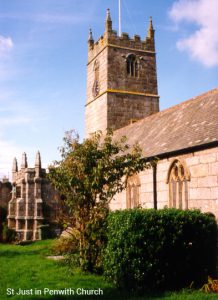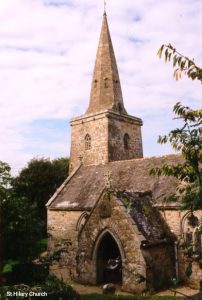Churches in the Cornish Landscape
Penwith churches with Grenfell connections
 Pascoe Grenfell 1761-1838 was likely most familiar with the parish churches in west Cornwall, in the Hundred of Penwith (14 in West Penwith, 10 East Penwith), all within a compass of 10 miles from Marazion, place of his upbringing. All were late medieval rebuilds (the reconstruction process that had petered out in the 16th century) and at the time of his birth in 1761 still retained three centuries later both their medieval external appearance (Redruth’s St Euny excepted, being in the throes of an 18th-century reconstruction) and an unchanged distribution in the landscape.
Pascoe Grenfell 1761-1838 was likely most familiar with the parish churches in west Cornwall, in the Hundred of Penwith (14 in West Penwith, 10 East Penwith), all within a compass of 10 miles from Marazion, place of his upbringing. All were late medieval rebuilds (the reconstruction process that had petered out in the 16th century) and at the time of his birth in 1761 still retained three centuries later both their medieval external appearance (Redruth’s St Euny excepted, being in the throes of an 18th-century reconstruction) and an unchanged distribution in the landscape.
In the late 15th century William of Worcester wrote of St Just in Penwith, the church of Pascoe’s forebears, that it was the burial place of the saint of that name. This may account for the conjecture that the first “church” on the site was founded by St Just in the 6th century, the first of at least three on the spot previous to the late-medieval structure surviving today. From the curving western boundary of the graveyard, it has been suggested that the cell St Just erected was later enclosed and initially replaced by an oratory chapel. Until his paternal grandfather’s migration to Penzance early in the 1700s, Pascoe Grenfell’s ancestors had worshipped at the church for generations.
 Penwith’s churches dominate their parishes and are evenly spread across the peninsula – the size of each church a reflection of the extent and wealth of the individual parish. All pre-date the parochial system which, evolving in Cornwall as part of the process of Anglicisation, is deemed no older than the 12th century. As is true of elsewhere in Cornwall, natural features such as river valleys were utilised to form parts of parish boundaries. Sometime before Pascoe’s birth, his father had shifted from Penzance to Marazion, whose parish church two miles distant at St Hilary in East Penwith was a late medieval rebuild like its neighbours, but its tower, which was 13th century, was untypically topped by a spire. Whether it is on the site of an ancient burial ground has not been argued, but St Hilary’s dedication to a Breton saint puts it among the 75/80 per cent of Cornish churches that either bear the name of a saint or have an ecclesiastical place name element, such as lann (enclosure) or eglos (church) in the name.
Penwith’s churches dominate their parishes and are evenly spread across the peninsula – the size of each church a reflection of the extent and wealth of the individual parish. All pre-date the parochial system which, evolving in Cornwall as part of the process of Anglicisation, is deemed no older than the 12th century. As is true of elsewhere in Cornwall, natural features such as river valleys were utilised to form parts of parish boundaries. Sometime before Pascoe’s birth, his father had shifted from Penzance to Marazion, whose parish church two miles distant at St Hilary in East Penwith was a late medieval rebuild like its neighbours, but its tower, which was 13th century, was untypically topped by a spire. Whether it is on the site of an ancient burial ground has not been argued, but St Hilary’s dedication to a Breton saint puts it among the 75/80 per cent of Cornish churches that either bear the name of a saint or have an ecclesiastical place name element, such as lann (enclosure) or eglos (church) in the name.
Cornwall’s churches – built at a time when the county had few villages or towns to speak of and the settlement pattern comprised scattered farmsteads and hamlets – were often sited in rural isolation, alongside a road and later amid a small cluster of dwellings that became known as the church-town. If the siting of the churches had once borne “a sensible or practical relationship to the distribution of Cornish people” – centrally located to the dispersed population to which they ministered – they had become by the 18th century, owing to dramatic population growth and changing demographics, “stranded in the geography of the medieval past” and were inappropriately placed to meet the needs of their parishioners.
When in 1818 the Church Building Act removed the necessity of passing individual Acts of Parliament, the Church of England set about on “the erection of new churches and the division of parishes”, in a sustained effort to improve parochial provision and meet head on the challenges posed by a countrywide population explosion. Cornwall gained four new churches at St Day (1828), Chacewater (1828) , Redruth Chapel of Ease (1828) and Penzance (1832-5), all built to the designs of a Cornishman from St Buryan, Charles Hutchens. (Until the larger church replaced it, Penzance’s chapel of ease, St Mary’s, had since the late-14th-century served the town whose parish church was at Madron.) In 1884 the Victorian architect J D Sedding spoke of the impact on the landscape of “Cornwall’s older churches”. There was, he mooted, “an indefinable something which makes them seem more identified with the local surroundings than is the case with church architecture in other parts of England. These simple structures seem to be part of the simple nature of the moor and down which surround them”. Whether Pascoe Grenfell ever expressed similar sentiments cannot be known; his views on Cornish churches – generally or in the landscape – have evaded documentation.
Penny Watts-Russell

